The Automotive Starting System Market is estimated to be valued at USD 21.8 billion in 2025 and is projected to reach USD 39.0 billion by 2035, registering a compound annual growth rate (CAGR) of 6.0% over the forecast period.
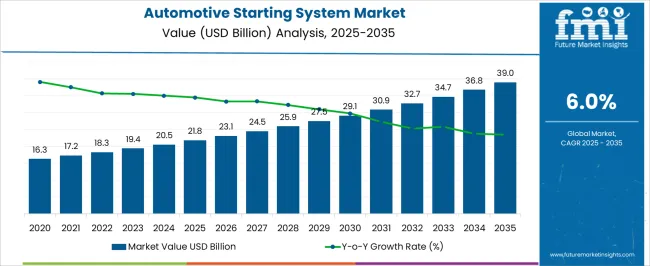
| Metric | Value |
|---|---|
| Automotive Starting System Market Estimated Value in (2025 E) | USD 21.8 billion |
| Automotive Starting System Market Forecast Value in (2035 F) | USD 39.0 billion |
| Forecast CAGR (2025 to 2035) | 6.0% |
The automotive starting system market is witnessing steady expansion, supported by the increasing demand for reliable and efficient vehicle ignition technologies across both passenger and commercial vehicles. The rising production of automobiles worldwide, coupled with stricter fuel efficiency and emissions standards, is influencing the development of more advanced and energy-efficient starting mechanisms.
The growing adoption of vehicles with start-stop functionality is further driving the market, as manufacturers focus on integrating systems that reduce idle fuel consumption while ensuring smooth engine restarts. Technological progress in electrical components, lightweight materials, and compact system designs is enhancing overall vehicle performance, reliability, and durability.
The shift toward electrification in the automotive sector is also contributing to new opportunities, as hybrid and electric vehicles require innovative starting technologies adapted for advanced powertrain architectures As consumer preferences evolve and regulations tighten, the automotive starting system market is positioned to grow steadily, driven by the need for efficient, cost-effective, and environmentally compliant ignition solutions.
The automotive starting system market is segmented by types, starting system, and geographic regions. By types, automotive starting system market is divided into Electric, Pneumatic, Hydraulic, and Non motor. In terms of starting system, automotive starting system market is classified into Direct current starting system, Two point starter, Three point starter, Four point starter, Alternate current starting system, Direct online starter, Star delta starter, Auto transformer starter, Semi-automatic star delta starter, and Automatic delta starter. Regionally, the automotive starting system industry is classified into North America, Latin America, Western Europe, Eastern Europe, Balkan & Baltic Countries, Russia & Belarus, Central Asia, East Asia, South Asia & Pacific, and the Middle East & Africa.
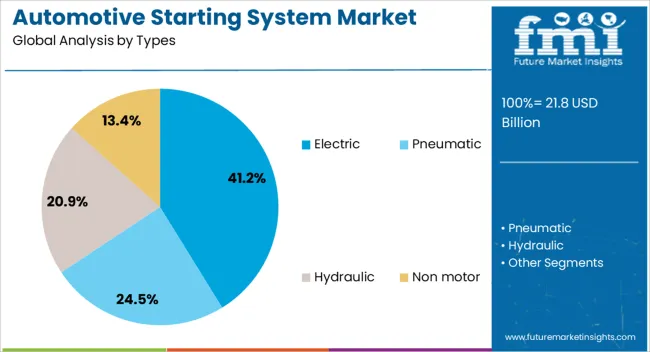
The electric starting system segment is projected to hold 41.2% of the automotive starting system market revenue share in 2025, establishing itself as the leading type. This dominance is being supported by its widespread adoption in modern vehicles due to high efficiency, convenience, and reliability compared to older mechanical alternatives. The ability of electric starters to provide quick and consistent engine ignition has reinforced their role as the standard system across passenger cars and light commercial vehicles.
Advancements in electrical engineering have improved durability, reduced component size, and enhanced energy efficiency, further driving their use. The segment’s growth is also being reinforced by the increasing adoption of vehicles equipped with start-stop technology, which relies heavily on electric starters for repeated and seamless operations.
The compatibility of electric systems with both conventional and hybrid powertrains provides additional scalability for future applications As automotive manufacturers continue to prioritize fuel efficiency and consumer comfort, electric starting systems are expected to retain their dominant position in the global market.
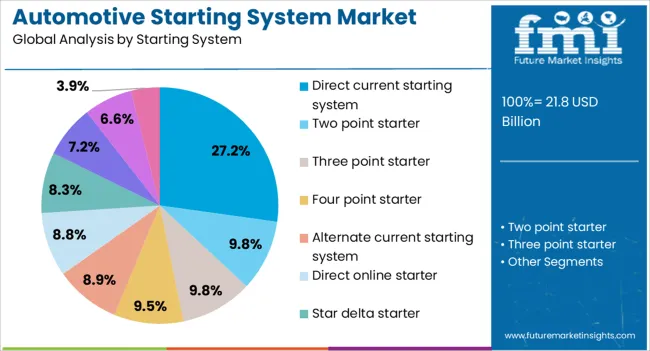
The direct current starting system subsegment within electric starters is anticipated to account for 27.2% of the automotive starting system market revenue share in 2025, making it the leading subcategory. Its leadership is being driven by proven reliability, ease of design integration, and cost-effectiveness, which have made it a widely adopted solution in both passenger and commercial vehicles. The segment benefits from its ability to deliver high torque output with compact construction, ensuring efficient engine cranking even under varied operating conditions.
Continuous improvements in direct current motor efficiency, coupled with advancements in brush and commutator technologies, have enhanced performance and longevity. The subsegment’s strong market position is also being supported by its adaptability to modern vehicle requirements, including compatibility with start-stop systems and hybrid applications.
Manufacturers are favoring direct current designs due to their scalability and lower production costs, making them suitable for mass-market vehicles As global vehicle production rises and demand for efficient yet economical systems increases, the direct current starting system is expected to maintain its strong foothold in the market.
The automotive starting system market size is growing due to the rising demand for electric vehicles and the rapidly increasing production of other vehicles too during the forecast period. The key manufacturers develop several automotive starting system devices such as hydraulic starters, hand crank starters, and pneumatic starters as per end-users demand.
Moreover, the automotive starting system includes several components such as a switch, starter motor, battery and solenoid. These components play a key role in providing power to a vehicle and are likely to increase the demand for automotive starting systems in the automotive industry. On the other hand, growing technologies reduced C02 emissions, and increasing efficiency in vehicles are accelerating the demand as per the global automotive starting system market report.
Based on vehicle types, the market is categorized into PC (Passenger Cars), LCV (Light Commercial Vehicles), and HCV (Heavy Commercial Vehicles). PC (Passenger Cars) dominate the market by contributing the maximum share in the market during the forecast period. Rising numbers of passengers, a growing population, and growing disposable income are increasing the demand for passenger cars during the forecast period.
Passenger cars include several advanced features that attract end-users demand and are flourishing in the market size in recent years. Some of the modern features, including sensors, push-buttons, computer-controller starters, and remote starting, are likely to increase the adoption of passenger cars.
On the other hand, LCVs (Light Commercial Vehicles) and HCV (Heavy Commercial Vehicles) are also capturing a significant share of the global market during the forecast period. Light commercial vehicles include an electric automotive starting system which is more convenient, powerful and efficient. Moreover, it takes less time to get installed, surging the demand for LCVs in recent years. However, HCV takes minimum time to start the engine and smoothly function with its electric starters are growing the market size during the forecast period.
Based on region, the market is segmented into North America, Europe, Asia Pacific, MEA and Latin America. The Asia Pacific dominates the market by capturing the maximum share during the foreseen time. The countries such as India, China and South Korea are the hub of the automotive industry during the forecast period. The growing infrastructure and presence of key manufacturers are surging the market size in the region.
Automation is the need of the hour as the automotive industry growth is subsequently high, the need for advanced technologies and provision of smart features are playing as a vital role in the growth of automotive industry. Automotive starting system are considered as the heart of the vehicle.
Automotive starting system is a combination of mechanical and electrical components that works together to start the vehicle engine. In an automotive starting system, the electrical energy from the battery power converts into mechanical energy resulted into cranking the engine.
The starting system consists of housing, field coils, an armature, a commutator and brushes, end frames and a solenoid operated shift mechanism. Automotive starter enables the safe and hassle free start or ignition of the vehicle engine.
Over the last decade various companies are indulged in the continuous research and developments to make the automotive starter systems more superior and user friendly over the manual starting system in order to enhance the functionality and durability of automotive starting systems and tap the demand for technologically advanced automotive starting systems market, which is fostering the growth for global automotive starting system market.
The aftermarket for the automotive starting system is also contributing to the growth of global automotive starting systems market. Overall, the global automotive starting systems market is anticipated to register a healthy CAGR over the forecast period.
The global automotive starting system market is primarily driven by the demand of vehicles with premium features such as automation in starting system. Moreover, the automotive market growth rate has shown significant elevation after the global recession of 2007 to 2009 in terms of production and demand, which in turn is driving the global market for automotive starting system.
The need for technologically advanced automotive starting systems capable of increasing the fuel efficiency and reduced CO2 emissions in the vehicles are also having a positive impact on the global automotive starting systems market.
However, the volatile costs related to the production of the automotive starting systems can pose as a restraint to the global automotive starting systems market.
The global automotive market is segmented into seven regions: North America, Latin America, Western Europe, and Eastern Europe, APEJ, Japan and Middle East and Africa. Among the aforementioned regions, the APEJ market dominates the global automotive starting system market.
The countries as such China, India, and South Korea being the major hub for automobile market in the region is fostering the growth for automotive starting system market in the region. The Latin America and Western Europe market for automotive starting system is followed by the APEJ market in terms of market share.
The developing regions and under developed regions like Middle East and Africa are also expected to show modest growth rates over the forecast period with growth of automotive aftermarket in the regions. Overall the automotive starting system is expected to register healthy growth over the forecast period.
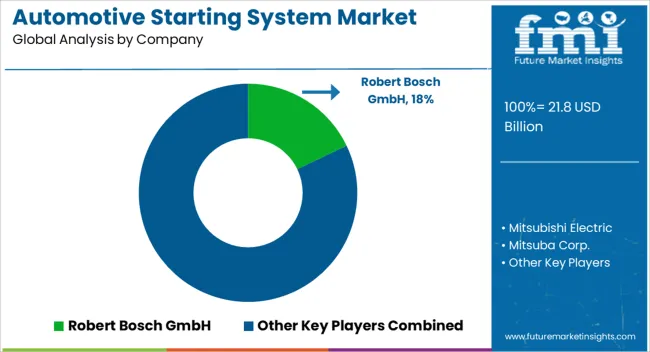
Some of the key players identified in the global automotive starting system market includes:
The research report presents a comprehensive assessment of the market and contains thoughtful insights, facts, historical data, and statistically supported and industry-validated market data. It also contains projections using a suitable set of assumptions and methodologies. The research report provides analysis and information according to market segments such as geography, technology and applications.
The report is a compilation of first-hand information, qualitative and quantitative assessment by industry analysts, inputs from industry experts and industry participants across the value chain. The report provides in-depth analysis of parent market trends, macro-economic indicators and governing factors along with market attractiveness as per segments. The report also maps the qualitative impact of various market factors on market segments and geographies.
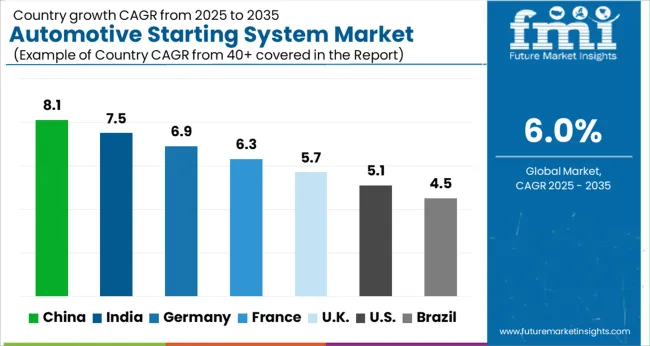
| Country | CAGR |
|---|---|
| China | 8.1% |
| India | 7.5% |
| Germany | 6.9% |
| France | 6.3% |
| UK | 5.7% |
| USA | 5.1% |
| Brazil | 4.5% |
The Automotive Starting System Market is expected to register a CAGR of 6.0% during the forecast period, exhibiting varied country level momentum. China leads with the highest CAGR of 8.1%, followed by India at 7.5%. Developed markets such as Germany, France, and the UK continue to expand steadily, while the USA is likely to grow at consistent rates. Brazil posts the lowest CAGR at 4.5%, yet still underscores a broadly positive trajectory for the global Automotive Starting System Market. In 2024, Germany held a dominant revenue in the Western Europe market and is expected to grow with a CAGR of 6.9%. The USA Automotive Starting System Market is estimated to be valued at USD 7.9 billion in 2025 and is anticipated to reach a valuation of USD 13.1 billion by 2035. Sales are projected to rise at a CAGR of 5.1% over the forecast period between 2025 and 2035. While Japan and South Korea markets are estimated to be valued at USD 1.2 billion and USD 646.0 million respectively in 2025.
| Item | Value |
|---|---|
| Quantitative Units | USD 21.8 Billion |
| Types | Electric, Pneumatic, Hydraulic, and Non motor |
| Starting System | Direct current starting system, Two point starter, Three point starter, Four point starter, Alternate current starting system, Direct online starter, Star delta starter, Auto transformer starter, Semi-automatic star delta starter, and Automatic delta starter |
| Regions Covered | North America, Europe, Asia-Pacific, Latin America, Middle East & Africa |
| Country Covered | United States, Canada, Germany, France, United Kingdom, China, Japan, India, Brazil, South Africa |
| Key Companies Profiled | Robert Bosch GmbH, Mitsubishi Electric, Mitsuba Corp., Wai Global, Lucas Electrical Limited, Besoto starting system Pvt. Ltd., Auto lek Pvt. Ltd., Koher Automotive Services, and Ruian Runrun Auto Parts Co., Ltd. |
The global automotive starting system market is estimated to be valued at USD 21.8 billion in 2025.
The market size for the automotive starting system market is projected to reach USD 39.0 billion by 2035.
The automotive starting system market is expected to grow at a 6.0% CAGR between 2025 and 2035.
The key product types in automotive starting system market are electric, pneumatic, hydraulic and non motor.
In terms of starting system, direct current starting system segment to command 27.2% share in the automotive starting system market in 2025.






Our Research Products

The "Full Research Suite" delivers actionable market intel, deep dives on markets or technologies, so clients act faster, cut risk, and unlock growth.

The Leaderboard benchmarks and ranks top vendors, classifying them as Established Leaders, Leading Challengers, or Disruptors & Challengers.

Locates where complements amplify value and substitutes erode it, forecasting net impact by horizon

We deliver granular, decision-grade intel: market sizing, 5-year forecasts, pricing, adoption, usage, revenue, and operational KPIs—plus competitor tracking, regulation, and value chains—across 60 countries broadly.

Spot the shifts before they hit your P&L. We track inflection points, adoption curves, pricing moves, and ecosystem plays to show where demand is heading, why it is changing, and what to do next across high-growth markets and disruptive tech

Real-time reads of user behavior. We track shifting priorities, perceptions of today’s and next-gen services, and provider experience, then pace how fast tech moves from trial to adoption, blending buyer, consumer, and channel inputs with social signals (#WhySwitch, #UX).

Partner with our analyst team to build a custom report designed around your business priorities. From analysing market trends to assessing competitors or crafting bespoke datasets, we tailor insights to your needs.
Supplier Intelligence
Discovery & Profiling
Capacity & Footprint
Performance & Risk
Compliance & Governance
Commercial Readiness
Who Supplies Whom
Scorecards & Shortlists
Playbooks & Docs
Category Intelligence
Definition & Scope
Demand & Use Cases
Cost Drivers
Market Structure
Supply Chain Map
Trade & Policy
Operating Norms
Deliverables
Buyer Intelligence
Account Basics
Spend & Scope
Procurement Model
Vendor Requirements
Terms & Policies
Entry Strategy
Pain Points & Triggers
Outputs
Pricing Analysis
Benchmarks
Trends
Should-Cost
Indexation
Landed Cost
Commercial Terms
Deliverables
Brand Analysis
Positioning & Value Prop
Share & Presence
Customer Evidence
Go-to-Market
Digital & Reputation
Compliance & Trust
KPIs & Gaps
Outputs
Full Research Suite comprises of:
Market outlook & trends analysis
Interviews & case studies
Strategic recommendations
Vendor profiles & capabilities analysis
5-year forecasts
8 regions and 60+ country-level data splits
Market segment data splits
12 months of continuous data updates
DELIVERED AS:
PDF EXCEL ONLINE
Automotive Direct Liquid Cooling IGBT Module Market Size and Share Forecast Outlook 2025 to 2035
Automotive Hoses and Assemblies Market Size and Share Forecast Outlook 2025 to 2035
Automotive Network Testing Market Size and Share Forecast Outlook 2025 to 2035
Automotive Performance Part Market Size and Share Forecast Outlook 2025 to 2035
Automotive Carbon Ceramic Brake Market Size and Share Forecast Outlook 2025 to 2035
Automotive Camshaft Market Size and Share Forecast Outlook 2025 to 2035
Automotive Stamping Industry Analysis in India Size and Share Forecast Outlook 2025 to 2035
Automotive Cylinder Liner Market Size and Share Forecast Outlook 2025 to 2035
Automotive Microcontroller Market Size and Share Forecast Outlook 2025 to 2035
Automotive Roof Rails Market Size and Share Forecast Outlook 2025 to 2035
Automotive Diagnostic Scan Tool Market Size and Share Forecast Outlook 2025 to 2035
Automotive Test Equipment Market Size and Share Forecast Outlook 2025 to 2035
Automotive Dynamic Map Data Market Size and Share Forecast Outlook 2025 to 2035
Automotive Green Tires Market Size and Share Forecast Outlook 2025 to 2035
Automotive E-Tailing Market Size and Share Forecast Outlook 2025 to 2035
Automotive Interior Market Forecast Outlook 2025 to 2035
Automotive Key Market Size and Share Forecast Outlook 2025 to 2035
Automotive Appearance Chemical Market Forecast and Outlook 2025 to 2035
Automotive Seating Market Forecast and Outlook 2025 to 2035
Automotive Domain Control Module Market Forecast and Outlook 2025 to 2035

Thank you!
You will receive an email from our Business Development Manager. Please be sure to check your SPAM/JUNK folder too.
Chat With
MaRIA